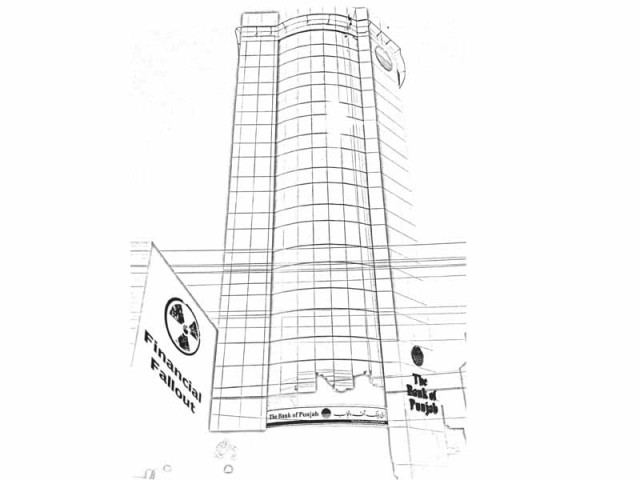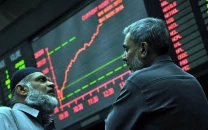Debris of a crisis: Three years on, Bank of Punjab still a market pariah
Banks refuse to lend to it without substantial collateral; investors jettisoning exposure.

In boardrooms up and down Karachi’s I.I. Chundrigar Road, Bank of Punjab is a four-letter word. Hardly anybody wants to talk about it and almost nobody wants to do business with it. Yet curiously enough, even though most people believe its liabilities far exceed its assets, nobody actually thinks it will go bankrupt or shut down.
This confidence in the survival of an institution that has not issued financial statements since 2008 – even though it is legally required to make its accounts public every quarter – is based on one simple premise: the fact that the bank’s majority shareholder, with an over 51% stake, is the government of Punjab.
“The Bank of Punjab will not go down,” said one senior treasury official at one of the largest five banks in the country. “The Punjab government won’t let it.”
Investors run away
Yet this same banker also said that his bank avoided lending to BOP in the “clean” interbank lending market, i.e. where banks lend to each other based purely on their creditworthiness and without collateral.
BOP is still able to borrow money in the repo market, where it is borrowing against treasury bills that it pledges as collateral. In that market, BOP is able to borrow up to 98% of the value of its government securities portfolio, said sources familiar with the matter.
Aslam Lodhi, spokesperson for the Bank of Punjab, acknowledged that the BOP had trouble raising funds in the interbank market, though he insisted that the bank was on sound financial footing.
Meanwhile, investors have been unwilling to touch the Bank of Punjab with a ten-foot pole since 2008. The bank’s stock – listed on the Karachi Stock Exchange – has dropped 77% over the last three years, closing at Rs5.77 per share on Friday. It had briefly rallied to around Rs20 in December 2009 when it seemed that the bank might issue its financial statements at least, but the rally has since fizzled into a slow decline since then.
Institutional investors, meanwhile, have been clearing out their exposure to the bank. Faysal Asset Management had about Rs1.8 billion in term deposits at the bank that it chose to close out. The Employees Old-Age Benefits Institution (EOBI) – the second largest institutional investor in the country with over Rs220 billion in assets under management – refused to buy Bank of Punjab shares when they were offered at a steep discount, according to sources familiar with the matter.
Opaque financials
The 2008 annual report is the last time the bank issued financial statements. Nobody except a few of the bank’s senior-most officials and a select few at the State Bank of Pakistan – BOP’s regulator – knows the current financial health of the company.
Nonetheless, most market sources estimate that the Bank of Punjab’s equity is negative by between Rs10 billion and Rs12 billion, meaning its liabilities exceed its assets by that amount. Sources at the State Bank of Pakistan confirmed that the number was in that general range, but asked The Express Tribune not to disclose the precise number.
The negative equity is despite a Rs10 billion bailout that the bank got through an injection of equity by the government of Punjab in 2009. Central bank sources also say that the regulator has been working feverishly to engineer a solution to the bank’s problem, but had not yet been able to finalise any arrangement that would rescue BOP. Until then, it is unlikely that the financial statements will be issued.
How exactly BOP got into this mess remains unclear. There have been allegations of politically connected companies such as Haris Steel borrowing billions of rupees above their normal credit limit by using fraudulent methods and in connivance with bank officials. The bank’s former president Hamesh Khan was even extradited from the United States – the first time that the US has ever extradited a fugitive to Pakistan – to face charges of mismanagement and corruption.
But most see the prosecution of Hamesh Khan and Haris Steel as a ruse to cover up even deeper troubles.
“Hamesh Khan appears to be a fall guy,” said one senior banker in Karachi. “Nobody still has any idea what really happened at that bank.”
Political connections
Many, however, are more than willing to speculate. In the tight-knit community of corporate bankers, there is much talk of how the bank’s fortunes seem to be tied to one of the biggest political rivalries in Punjab: that between the Pakistan Muslim League Nawaz (PML-N) and the Pakistan Muslim League Quaid (PML-Q).
There have been persistent rumours of how then Punjab Chief Minister Chaudhry Pervaiz Elahi of the PML-Q used the bank to funnel money towards the businesses of friends and associates. Yet even though the bank ran into trouble during the tenure of the PML-Q, the PML-N appears determined to save it.
“The Sharifs will not privatise the Bank of Punjab. It is their baby. They created it and ran it well,” said a senior banker who wished to remain anonymous.
He was referring to the fact that the bank was created in 1989, during Shahbaz Sharif’s first term as Punjab chief minister. The bank had been profitable in the decade leading up to 2008. That year, the first after the PML-Q government left office, it faced a Rs10 billion loss. As many depositors worried and fled the bank, its assets declined from Rs235 billion in 2007 to Rs186 billion in 2008, a 21% drop.
The bank is still, however, viewed as an attractive investment opportunity – given the right price. It has 237 branches and has the government of Punjab as a captive client. The provincial government keeps nearly all of its money at the bank, most often in checking accounts, giving BOP an incredibly low cost of funds.
The market, it seems, is assuming that the Punjab government will recognise that value and eventually arrange for the second bailout.
Published in The Express Tribune, October 31st, 2011.



















COMMENTS
Comments are moderated and generally will be posted if they are on-topic and not abusive.
For more information, please see our Comments FAQ